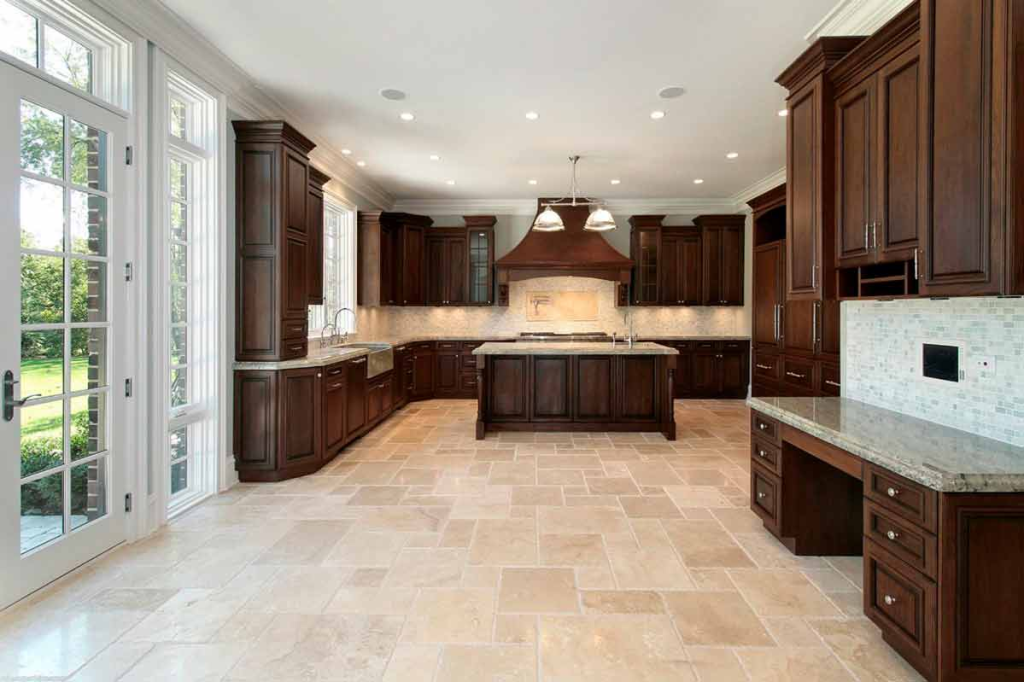Marble tiles bring elegance to any space, and kitchens are no exception. Even in a simple layout, marble can elevate the look and add a touch of luxury. However, in Indian homes, where the kitchen is in constant use, from cutting and scrubbing to oil splashes and hot pans, the choice of kitchen tile design needs to extend beyond aesthetics.

While real marble is known for its beauty, it’s also known for being high-maintenance. That’s where marble tiles offer the best of both worlds. They bring the charm of marble, with the durability and ease of modern materials like vitrified and porcelain.
This post breaks down the pros and cons clearly, so if you’re considering marble tiles for your kitchen, it’ll help you decide whether the beauty outweighs the upkeep.
Post Contents
Why Marble Tiles Look So Good in Kitchens?
Marble gives kitchens an effortless sense of elegance. The modern tile-making technology captures the veining, shine, and subtle colour tones of real marble without its fragility.
Each tile may feature natural-looking variations, which adds to the personalised feel. They work beautifully in small kitchens by reflecting light, making the space feel brighter. And in larger kitchens, they bring an understated luxury that’s easy to match with most colour schemes.
The Pros of Using Marble-Like Tiles as Your Kitchen Tile Design
There are a few good reasons people keep coming back to marble tiles, especially for walls and flooring in cooking spaces.
Unlike natural marble, these tiles are non-porous and don’t absorb stains easily. This makes them low-maintenance, where a swipe of a mop can easily remove spilled tea, spices, or oil.
They also work across different design themes. Whether your cabinets are wood-finish or glossy white, marble tiles tend to blend well. Not only that, marble tiles are also widely available. Most tile shops carry a range of marble-inspired options, and most likely will bring you what you imagined.
Finally, you get the upscale look of marble without the cost and upkeep, and the installation is also easier.
The Cons of Using Marble as Your Kitchen Tile Design
While the marble-inspired tiles solve many of the real marble’s problems, there are still a few points to keep in mind. And its biggest problem is the grout lines. Especially in high-traffic kitchens, these lines can collect dirt in no time. However, using larger-format tiles can help reduce this.
Though tougher than marble, dragging heavy appliances across the floor can still leave marks. On the other hand, some cheaper variants from non-reputed brands may have repetitive patterns that look artificial. For a natural look, you need visual matching and should stick to premium collections like Double Charge or Altagloss.
Where Marble Tiles Work Best in a Kitchen
Just because marble tiles need a little care in high-traffic kitchens does not mean they are off-limits. It depends on where and how you plan to use them.
They work very well in the space between your countertop and wall cabinets. It gets some splashes but is not walked on or dragged over, so damage is limited. A polished marble finish here can act as a highlight. Collections like Marmorica, Kitchdeck, and Forza from premium suppliers like Simpolo Tiles and Bathware offer the richness of marble design but are easier to live with, especially in busy Indian households.
They also work on kitchen walls or partial elevations, especially if you are trying to create zones within the space. For example, using marble tiles behind a coffee station or baking area can visually separate the space.
Always compare marble tiles with other tile types before finalising your kitchen tile design. Sometimes, going for a marble-inspired finish in vitrified or porcelain material gives you both style and strength.
Preview Your Kitchen Tile Design Before You Install
On the other hand, it is essential to check your marble before installation to ensure it complements your lighting and furniture.
To do so, you can use visualisation tools. Premium brands like Simpolo Tiles and Bathware offer a Virtual Space Creator, allowing you to view tile collections in a digital 3D kitchen environment. You can try different colours, finishes, wall styles, and floor plans without leaving your home.
They also use Smart Code Technology. It lets you scan a code on the tile and preview how it will look in 360 degrees, along with real furniture, counters, and lighting options.
Conclusion
The thing with marble is that it requires your effort and attention. If you cook often, if your kitchen endures high foot traffic, or if you don’t have time to clean the grout or do weekly mopping, then a full marble kitchen might tire you out. But if design is important to you, and you are willing to give it that extra attention, marble tiles can become the standout feature of your kitchen.
Make decisions that suit your home. Because your kitchen tile designs should look good, cooperate with you, and still make you smile after years of use.